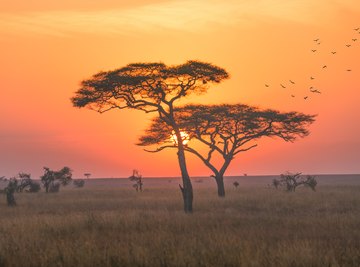
Different types of grasslands share similar characteristics. Savannas have scattered trees and predominate in certain parts of Africa, South America, Australia and Asia. Temperate grasslands are largely devoid of trees, receive less rainfall than savannas and endure broader temperature extremes. The two types of temperate grasslands are steppes and prairies. Steppes have shorter grasses, and prairies have taller grasses due to higher precipitation. You can find both types of temperate grasslands throughout North America and Europe. Read on to learn more about grasslands.
Precipitation in the Grasslands
Grasslands make up 25 percent of the Earth's land surface and dominate in regions with limited rainfall, which prevents forest growth. This is the result of nearby mountain ranges that cause rain shadows over adjacent open range lands. Typically, grasslands have not only limited but also unpredictable rainfall, and droughts are common. Where rainfall is even less, deserts will form. Savannas, on average, receive roughly 76 to 101 centimeters (30 to 40 inches) of rain per year, but steppes only average 25 to 51 centimeters (10 to 20 inches) per year. Prairies tend to be intermediate between savannas and steppes with 51 to 89 centimeters (20 to 35 inches) per year.
Temperature in the Grasslands
Temperatures vary much more in temperate grasslands than they do in savannas. Savannas are in warm climates with average annual temperatures that only vary between 21 and 26 degrees Celsius (70 and 78 degrees Fahrenheit). They typically have only two seasons, a wet and a dry season. Temperate grasslands have hot summers where temperature can exceed 38 degrees Celsius (100 degrees Fahrenheit) and cold winters that can drop below negative 40 degrees Celsius (negative 40 degrees Fahrenheit).
Fire in the Grasslands
Fires are an important grassland characteristic. Regular fires promote the growth of native grasses but limit the growth of trees. Native grasses have deeper root systems that can survive fires, but invasive plants tend to have shallower roots and succumb to fires. Development has curtailed the number and extent of grassland fires, and the lack of seasonal fires threatens the health of the world's grasslands. Only 5 percent of the world’s grasslands are being protected and maintained, and they remain the most endangered biome in the world.
Flora and Fauna
Savannas are home to some of the largest mammals on the planet such as elephants, giraffes, rhinos, lions and zebras. Temperate grasslands are also home to large mammals, particularly bison and horses, medium-sized mammals like deer, antelope and coyotes, as well as small mammals such as:
- mice
- jack rabbits
The type of grasses that grow depend upon the amount of rainfall. Shorter steppe grasses often consist of buffalo grass, and savanna grasses will contain taller grasses like bluestem and rye.
References
About the Author
John Peterson published his first article in 1992. Having written extensively on North American archaeology and material culture, he has contributed to various archaeological journals and publications. Peterson has a Bachelor of Arts from Eastern New Mexico University and a Master of Arts from the University of Nebraska, both in anthropology, as well as a Bachelor of Arts in history from Columbia College.
